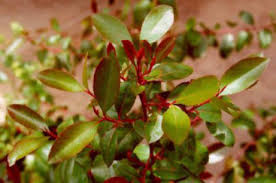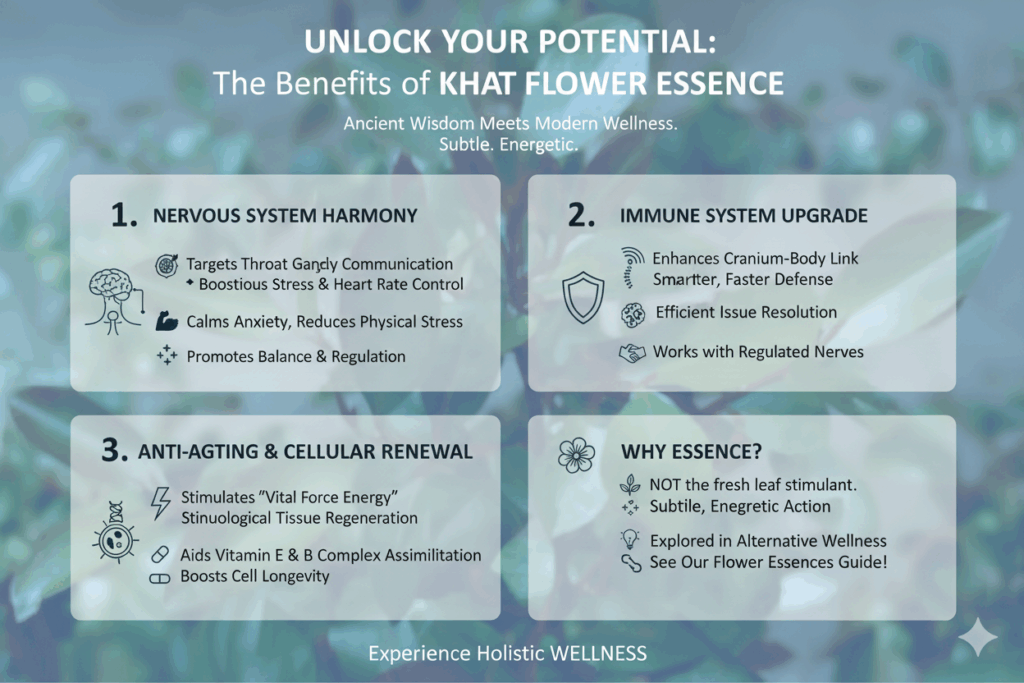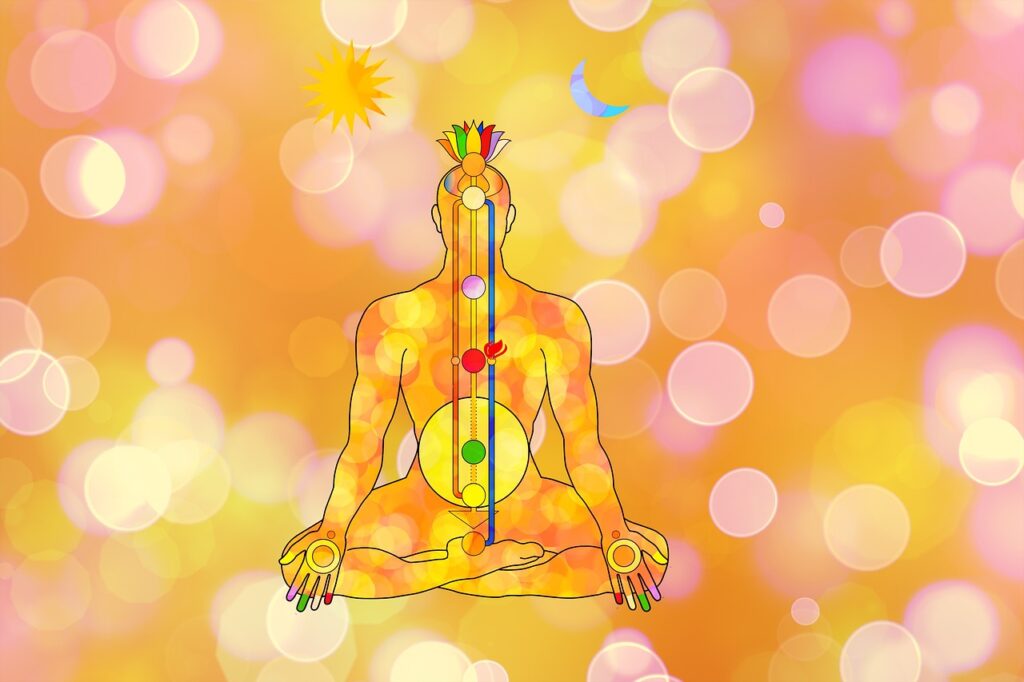Khat (Catha edulis) Benefits: Medicinal, Spiritual & Anti-Aging Uses
For centuries, high in the mountains of East Africa and the Arabian Peninsula, a remarkable plant has shaped social rituals and traditional healing. Catha edulis—better known as khat—has long been chewed for its stimulating effects, but today it’s drawing attention for something deeper. Modern wellness enthusiasts and researchers alike are exploring khat benefits that go far beyond a quick burst of energy. Its flower essence shows promise for strengthening the nervous system, enriching spiritual practice, and even supporting anti-aging at a cellular level.
In this guide you’ll discover the science and tradition behind khat, separate fact from fiction, and learn how to use this ethnobotanical safely and effectively as part of a modern wellness journey.

Unpacking the Science: How Khat Interacts with Your Body
The true magic of Khat’s flower essence lies in its sophisticated interaction with our body’s core systems. Unlike the fresh leaves, which are chewed for their cathinone-induced stimulant effect, the essence works on a more subtle, energetic level that is gaining interest in alternative wellness circles. For a deeper understanding of how these plant-based vibrational remedies work, you can explore our detailed guide to flower essences.
Primarily, the essence acts as a powerful catalyst for the nervous system. It specifically targets the nerve ganglia surrounding the throat, a crucial junction that connects to both the autonomic and parasympathetic nervous systems. This unique action is key—it essentially grants you a greater level of conscious control over involuntary bodily functions that are typically on autopilot, like your heart rate and stress response. By enhancing this communication, Khat flower essence can become a valuable tool for managing anxiety, reducing the physical symptoms of stress, and improving overall nervous system regulation, helping your body find its way back to a state of calm balance.

This neurological support doesn’t stop there. The benefits of Khat extend to a fascinating immune system boost. By improving the critical communication pathways between the cranium (the home of your brain) and the rest of your body, it helps stimulate the immune system to identify and resolve issues more efficiently. Think of it as upgrading your body’s internal communication network, allowing your natural defense systems to work smarter, not harder, in conjunction with a now-better-regulated nervous system.
Furthermore, many practitioners report significant anti-aging benefits of Khat. The proposed mechanism is truly captivating. It’s believed that the essence works by drawing “waves of vital force energy into the cells,” a process that stimulates the regeneration of delicate neurological tissues. This occurs as Khat strengthens the “ethereal fluidium,” or the vital energy field, that surrounds each cell. On a more practical, biochemical level, the essence is also known to aid significantly in the body’s assimilation of vitamin E and the entire complex of B vitamins, both of which are fundamental cornerstones for maintaining cellular health, integrity, and longevity.
Spiritual Awakening: Using Khat for Chakra Activation and Deeper Meditation
Beyond the physical body, Khat holds a revered place for its spiritual benefits. For those who feel stuck, lethargic, or lacking vision, the essence of Catha edulis is said to act as a key, unlocking higher states of awareness and deepening meditative practices.
The process often begins with a tangible physical activation. The essence is known to energize the coccyx (the base of the spine), the medulla oblongata (a critical part of the brainstem), and the body’s muscular tissue. This physical awakening is coupled with a powerful energetic shift: the activation of the third chakra, the solar plexus. This energy center is associated with personal power, will, and vitality. When balanced and activated, it fosters the confidence and focus needed for profound spiritual work.
This combination of physical and energetic stimulation makes it an invaluable aid for those seeking to enhance their meditation, allowing for sharper focus, reduced mental chatter, and a stronger connection to one’s inner vision.
If you wish to explore this path, it can be incorporated mindfully. A common method is to place 2-3 drops of a prepared Khat flower essence under your tongue shortly before beginning a meditation session. As you sit in stillness, allow the essence to enhance your focus and quiet mental distractions. For an even deeper experience, many find that combining it with chanting, breathwork, or creative visualization can unlock new layers of spiritual insight.
The most critical rule here is moderation; to avoid any potential for dependency or energetic overwhelm, this powerful practice should be limited to no more than once per week.
Khat for Anxiety: Understanding the Potential and the Precautions
Given its noted effects on the nervous system, a common question arises: can khat be used for anxiety relief ? Some users report feeling less worried or more mentally alert after using khat, but the science tells a more complex story. According to the PMC review on the chemistry, pharmacology, and toxicology of Khat (Catha edulis), mild anxiety reduction occurs temporarily in some cases—but those effects usually disappear by the next day, and there is no clear evidence that khat reliably modulates GABA receptors in humans to treat anxiety.
By acknowledging both the traditional uses and the scientific data, we gain a clear view: while khat benefits may include short-lived relief of stress and mental discomfort, using it as a long-term anxiety treatment requires much greater caution, proper dosage, and awareness of possible side effects. However, this is where a crucial discussion on safety and legality must take center stage. It is absolutely vital to distinguish between the controlled, minimal use of a prepared flower essence and the recreational chewing of fresh Khat leaves.
Navigating the Legal and Safety Landscape of Khat
The legal status of Khat is complex and varies dramatically across the globe. In many countries, including the United States, the fresh leaves and their primary active stimulant, cathinone, are classified as Schedule I controlled substances. This classification denotes a government stance that the substance has a high potential for abuse and no accepted medical use. Therefore, possessing, selling, or using fresh Khat leaves is illegal in these jurisdictions.
The legality of homeopathic dilutions or flower essences made from Khat often exists in a gray area, as they typically contain little to no detectable cathinone. However, the onus is on the consumer to understand and comply with their local laws. Beyond legality, safety is paramount. Consistent, heavy use of fresh Khat has been well-documented to lead to a range of negative health effects, including insomnia, hypertension, irritability, and gastrointestinal issues.
Furthermore, ceasing heavy use after a period of dependency can lead to noticeable withdrawal symptoms. These often mirror a crash from other stimulants and can include feelings of depression, significant lethargy, a notable lack of energy, an increased appetite, and difficulty concentrating. This starkly contrasts with the reported experience of the carefully prepared and minimally used flower essence, highlighting why source, preparation, and intent matter immensely.
Khat vs. Kratom: Choosing the Right Botanical Path
Many seekers of natural remedies often confuse Khat with another popular botanical: Kratom (Mitragyna speciosa). While both are plant-based and can have stimulant-like properties, they are distinctly different. This comparison can help clarify their unique roles:
- Primary Effect: Khat’s flower essence is primarily known for its focused stimulation and nervous system support. Kratom’ effects are dose-dependent; low doses tend to be stimulating, while high doses are sedating and analgesic.
- Best For: Khat is often sought for spiritual focus and addressing anxiety coupled with lethargy. Kratom is most commonly used for pain relief and mood enhancement.
- Legal Status: Fresh Khat is illegal in many Western nations. Kratom’s legality is a patchwork; it is legal in some places but banned or regulated in others.
- Side Effects: Khat’s negative effects are linked to fresh leaf abuse (insomnia, irritability). Kratom can cause nausea, constipation, and has a more documented potential for dependency with regular use.
Understanding these differences is crucial for making an informed and safe choice that aligns with your wellness goals and local regulations.

In conclusion, the benefits of Khat (Catha edulis) present a fascinating duality. The fresh plant is a controlled substance with a real potential for abuse, while its prepared flower essence is revered in holistic circles for its potential to heal, balance, and awaken. The key to unlocking its positive potential lies in respect—respect for its power, respect for the law, and respect for the intention behind its use. When approached with knowledge and caution, Khat remains one of the most intriguing tools in the world of ethnobotanical medicine.